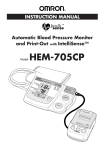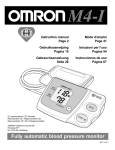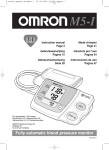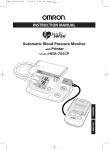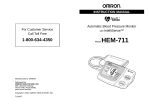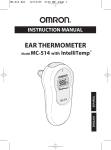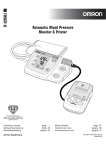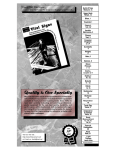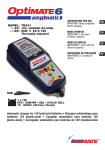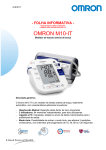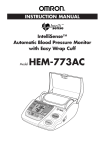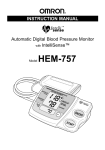Download Omron Healthcare T9P User's Manual
Transcript
T9P new (6) 7/17/02 6:05 PM Page 1 R INSTRUCTION MANUAL Automatic Blood Pressure Monitor and Print-Out with IntelliSense™ Model T9P T9P new (6) 7/17/02 6:05 PM Page 2 TITLE TABLE OF CONTENTS Introduction...................................................................................................3 Notes on Safety.............................................................................................4 Know Your Unit............................................................................................5 Quick Reference Guide ................................................................................6 Initial Set-Up ................................................................................................7 Battery Installation/Replacement............................................................7 How to Set Time and Date .....................................................................8 How to Use the Optional AC adapter.....................................................9 Correct Usage .............................................................................................10 How to Apply Arm Cuff .................................................................10, 11 How to Take a Reading ..................................................................12, 13 How to Use the Memory Function .......................................................14 Printing........................................................................................................15 How to Connect Printer-Unit................................................................15 How to Load Printer Paper...................................................................16 How to Use the Printer-Unit ....................................................17, 18, 19 Troubleshooting ....................................................................................20, 21 Care and Maintenance ................................................................................22 Specifications..............................................................................................23 About Blood Pressure .................................................................................24 2 T9P new (6) 7/17/02 6:05 PM Page 3 INTRODUCTION TITLE Thank you for purchasing the Omron Automatic Blood Pressure Monitor and Print-Out with IntelliSenseTM, T9P. Although your blood pressure fluctuates throughout the day, no self-adjustment is necessary as the monitor intelligently adjusts to your changing conditions. The IntelliSenseTM monitor uses fuzzy logic intelligence to sense both your systolic and diastolic blood pressure values, and the result is personalized inflation with every reading. Arm discomfort and misreading due to improper cuff inflation are virtually eliminated. Your new OMRON monitor uses the oscillometric method of blood pressure measurement. This means the monitor detects your blood’s movement through your brachial artery and converts the movements into a digital reading. At the push of a button, the monitor automatically fills the cuff with air, starts deflation, then displays your systolic, diastolic, and pulse readings on an extra large display panel. Please read this instruction manual thoroughly before using this unit. For specific information on your own blood pressure, CONTACT YOUR DOCTOR. 3 T9P new (10) 8/6/02 2:31 PM Page 4 NOTESTITLE ON SAFETY [ [ The warning signs and the sample icons shown here are listed for you to use the product safely and correctly as well as to prevent the risk and the damage to you and others from happening. The icons and meanings are as follow. Warning sign Caution Contents Indicates matters in which bodily harm or material damage* may arise as a result of incorrect handling. * Material damage refers to a wide range of damage involving your house, household goods, domestic animals, and pets. Examples of signs The icon indicates prohibitions (what you cannot do). Matters involving actual prohibitions are indicated by text or pictures in or near . The icon indicates something compulsory (always follow). Matters involving actual compulsory actions are indicated by text or pictures in or near . The left icon refers to "general compulsion". Caution Self-diagnosis of measured results and treatment are dangerous. Please follow the instructions of your doctor. Do not use the unit on infants or persons who cannot express one’s intention. Do not use the unit for any purpose other than measuring blood pressure. Do not use a cellular phone near the unit. Improper operation may result. Do not disassemble, repair, or remodel the main unit or the arm cuff of the blood pressure monitor. The battery liquid may leak and damage the main unit. Please observe the following points. When you are not going to use the unit for a long period of time (approximately three months or more), take out the batteries. Replace the worn batteries with new ones immediately. Do not use worn and new batteries together. Do not insert the batteries with their polarities in wrong direction. [ [ [ [ Do not force to bend the arm cuff or the air tube excessively. When removing the air tube, pull at the connector. Do not apply strong shock or drop the main unit. Do not inflate the arm cuff without it being wrapped on the arm. 4 T9P new (6) 7/17/02 6:05 PM Page 5 KNOWTITLE YOUR UNIT Main Unit: Heart Symbol AC Adapter Jack Adjust Date/Time Set Date/Time Systolic Blood Pressure Printer Jack Cuff Jack ON/OFF Button Diastolic Blood Pressure START Button Pulse Rate Memory Call Button Date/Time Display Printer-Unit: Printer Cover Printer Cable Plug Power/Operation Light Paper Feed Print Current Data/Stop Printing Print Graph Print All Data Accessories: Arm Cuff (Applicable arm cuff for Adults 22 to 32 cm.) Air Tube AC Adapter Air Plug (Connects to Air Jack) 5 (not a standard accessory) T9P new (6) 7/17/02 6:05 PM Page 6 TITLE QUICK REFERENCE GUIDE 1. Avoid eating, smoking, and exercising for at least 30 minutes before taking a measurement. 2. Remove tight-fitting clothing from your upper arm. 3. Sit in a chair with your feet flat on the floor and place your arm on a table so that the cuff is at the same level as your heart. 4. Put your arm through the cuff loop making sure that the bottom edge of the cuff is approximately 1-2 cm above the elbow and that the Green Marker on the cuff is above brachial artery. 1-2 cm Green Marker 5. Pull the end of the cuff so that the entire cuff is evenly tightened around your arm and press the hook material firmly against the pile side of the cuff. 6. Press the ON/OFF button. 7. After the Heart Symbol ( ) appears on the digital panel, press the Start button, and remain still until the measurement is complete. 8. When measurement is complete, the monitor displays your blood pressure and pulse rate, and automatically deflates the cuff. 9. Wait 2-3 minutes before taking another blood pressure measurement. You may require more rest time between readings depending on your individual physiological characteristics. 6 T9P new (6) 7/17/02 6:23 PM Page 7 TITLE BATTERY INSTALLATION/REPLACEMENT Main Unit: 1. Slide the battery cover off in the direction of the arrow. 2. Install or replace 4 "AA" size batteries so the + (positive) and – (negative) polarities match the polarities of the battery compartment as indicated. 3. Replace the battery cover. Notes: If the Low Battery Indicator ( ) appears on the display, replace all four batteries. Long-life alkaline batteries are recommended. Remove the batteries if the monitor will not be used for an extended period of time. 7 Printer Unit: T9P new (6) 7/17/02 6:05 PM Page 8 HOW TO SET TIME AND DATE TITLE 1. When the batteries are installed, the display will show 12:00a.m. 2. Press and hold the “SET” button. The year digits (2001) will flash. 3. Press the “ADJUST” button to advance the digit(s) one at a time. If you hold down the ADJUST button, the digits will advance rapidly. 4. Press “SET” button when desired number is on the display to lock setting. 5. Repeat Step 3-4 for month and date. 6. Repeat Step 3-4 for hour and minutes. 8 T9P new (6) 7/17/02 6:05 PM Page 9 HOW TITLE TO USE THE OPTIONAL AC ADAPTER To avoid potential damage to the monitor, use only the optional AC adapter specified by Omron distributor. To connect the AC adapter 1. Insert the AC adapter plug into the AC Adapter jack on the back of the main unit. 2. Plug in the AC adapter into the appropriate AC outlet. To remove the AC adapter To remove the AC adapter, disconnect the adapter plug from the AC outlet first and then disconnect the cord from the monitor’s jack. 1 NOTE: The monitor is designed not to draw power from the batteries when the AC adapter is in use. 9 2 T9P new (6) 7/22/02 9:47 AM Page 10 HOW TO APPLY THE ARM CUFF TITLE 1. If the cuff is assembled correctly, the hook material will be on the outside of the cuff loop and the metal D-ring will not touch your skin. 2. If the cuff is not assembled, pass the end of the cuff furthest from the tubing through the metal D-ring to form a loop. The smooth cloth should be on the inside of the cuff loop. IC TOL SYS LIC STO DIA E/min PULS Pile Side Material Sewn Hook Material 3. Sit in a chair with your feet flat on the floor and place your arm on a table so that the cuff is at the same level as your heart. 4. Put your arm through the cuff loop. The bottom of the cuff should be approximately 1-2 cm above the elbow. The Green Marker on the cuff should lie over the brachial artery on the inside of the arm. Tube should run down center of arm approximately even with middle finger. 10 D-Ring Bottom Edge 1-2 cm Cuff Tube Green Marker T9P new (6) 7/17/02 6:05 PM Page 11 TITLE TITLE HOW TO APPLY THE ARM CUFF 5. Pull the cuff so that the top and bottom edges are tightened evenly around your arm. 6. When the cuff is positioned correctly, press the sewn hook material FIRMLY against the pile side of the cuff. 7. Make certain the cuff fits snugly around your arm. The cuff should make good contact with your skin. You should be able to fit your index finger between the cuff and your arm easily, so you can pull the cuff off and on. 8. Relax your arm and turn your palm upward. 9. Be sure there are no kinks in the air tubing. You can also measure blood pressure on your right arm. Wrap the arm cuff as shown in the Figure. 1. Place the air tube below the elbow. 2. Place the mark cloth inside the elbow joint of your right arm. Mark cloth Air tube 11 T9P new (6) 7/17/02 6:05 PM Page 12 TITLE HOW TO TAKE A READING 1. Press the ON/OFF button. a) All display symbols appear for approximately one second. b) When the monitor becomes ready to measure, the Heart Symbol appears on the display. 2. Press the START button and remain still. As the cuff begins to inflate, the monitor automatically determines your ideal inflation level. Because this monitor detects the pulse even during inflation, do not move your arm and remain still until the entire measurement completes. 3. Inflation stops automatically and measurement is started. As the cuff slowly deflates, decreasing numbers appear on the display and the Heart Symbol ( ) flashes at every heartbeat. In rare circumstances, a higher inflation may be necessary. In those cases, the monitor reinflates the cuff up to 30 mmHg higher than initial inflation and restarts the measurement. 4. When the measurement is complete, the arm cuff completely deflates and your blood pressure and pulse rate are displayed. NOTE: The monitor automatically stores blood pressure and pulse rate into the memory. 5. Press the ON/OFF button to turn the monitor off. NOTE: If you forget to turn the monitor off, it will automatically shut itself off after five minutes. 12 Inflation Deflation T9P new (6) 7/17/02 6:05 PM Page 13 TITLE HOW TO TAKE A READING Instructions for special conditions: [ If your systolic pressure is known to be more than 220 mmHg, push and hold the START button until the monitor inflates 30 to 40 mmHg higher than your suspected systolic pressure. NOTE: Do not apply more pressure than necessary. The monitor will not inflate above 300 mmHg. [ If you want to stop the measurement, push the ON/OFF button. The monitor will stop inflating and start deflating rapidly, then the monitor will turn off. 13 START Continue to press button T9P new (6) 7/22/02 9:46 AM Page 14 TITLE HOW TO USE THE MEMORY FUNCTION This monitor has a memory capable of storing twenty-eight (28) sets of readings. Every time you complete the measurement, the monitor automatically stores blood pressure and pulse rate. [ [ Push the Symbol ( button to recall stored readings while the Heart ) is displayed. When twenty-eight (28) sets of readings are stored in memory, the oldest set will be deleted to store a new set. alternately displayed [ [ Date and Time of stored readings will be alternately displayed. To delete stored readings, press the button and the Start button simultaneously, then all the readings will be deleted. NOTE: You cannot delete the stored readings partially. START Press these two buttons at the same time. 14 T9P new (6) 7/17/02 6:05 PM Page 15 TITLE PRINTER UNIT HOW TO CONNECT 1. Remove printer cable plug from around printer unit. 2. Connect printer cable plug cord to the main unit. Arrow (8) on printer cable plug should face down to main unit. 15 T9P new (6) 7/17/02 6:05 PM Page 16 HOW TO LOAD PRINTER PAPER TITLE 1. Open printer cover in the direction indicated by the arrow symbol and remove paper roll from the main unit. 2. Peel off the glued edge of the printing paper included with the unit, and cut the first 10 cm with a pair of scissors. 3. Press the PAPER FEED button while inserting the edge of the printing paper into the paper feeding slot. When the edge of the paper protrudes sufficiently, release the PAPER FEED button. 4. Close the plastic printer cover. Make certain that the paper sticks out from the top when the cover is replaced. 5. Thermal sensitive paper is supplied with the unit. Use only thermal paper of similar size (width approx. 38mm) and roll diameter (not to exceed approx. 26mm). These rolls of paper (model number HEM - PAPER 759P) can be ordered from OMRON distributors. 16 10 c m T9P new (6) 7/17/02 6:05 PM Page 17 HOW TO USETITLE THE PRINTER-UNIT The T9P has the ability to print all the readings stored in memory. NOTE: [ [ [ [ [ Make sure printer-unit is connected to main unit (see How to Connect Printer-Unit) Do not use printer-unit without loading printer paper (see How to Load Printer Paper). Improper use will decrease operation life cycle of printer-unit. Main unit does NOT have to be ON to operate printer-unit. Printer-unit will automatically shut OFF when printing is completed. If you need to stop printing during printing process, press “DATA/STOP” button. 1. Press “DATA/STOP” to print measurement of most recent reading. The numeric print-out will look like the following example: Month/Date Systolic Reading Diastolic Reading Pulse Reading 7/9 6:36 AM Time SYS 111mmHg DIA 67mmHg PULSE 77/min 2. Press “ALL DATA” button to print a numerical list and average of all stored readings (stores a maximum of 28 readings). 17 T9P new (6) 7/17/02 6:05 PM Page 18 HOW TO USETITLE THE PRINTER-UNIT The numerical print-out will list all stored readings (maximum of 28 readings) starting with the most recent reading to last stored reading: Systolic Reading Column Month(s) Date Time/Hour [ [ [ Diastolic Reading Column 3-6 mmHg D. T. 20 15 23 11 1 15 3 14 5 7 15 7 20 12 3 12 10 12 12 14 14 7 21 15 22 12 4 6 *AV. SYS 113 117 113 110 112 110 106 110 108 111 107 111 121 112 112 /min DIA 75 69 71 67 66 61 66 65 61 56 64 64 62 64 65 PUL 67 64 63 66 64 64 65 64 67 62 64 64 66 63 65 Pulse Reading Column Last reading stored Most recent reading Average of all stored readings Month(s) The month or months will be printed. Example: If the blood pressure reading was stored between months March-June, then the printout will indicate “3-6”. Date Only the day’s date (1-31) will be printed. Example: If the blood pressure reading was stored on June 1st, then the printout will indicate 1 under the “D” column. Time/Hour Only the hour (24 hour format) will be printed. Example: if the blood pressure reading was stored at 3:00 PM, then the printout will indicate 15 under the “T” column. Note: If Time and Date was not initially set up before taking blood pressure measurement (see How to Set Time and Date) on printer-unit, the numerical value will not appear on print-out for month, time/hour and date.) 18 T9P new (6) 7/17/02 6:05 PM Page 19 HOW TO USETITLE THE PRINTER-UNIT 3. Press “GRAPH” button to print a graph of all stored readings (stores a maximum of 28 readings). Month(s) 3-6 50 100 mmHg 150 200 Last reading stored If reading is lower than 50 mmHg or higher than 200 mmHg, (; or :) will appear. Diastolic Reading Systolic Reading Most recent reading Average diastolic reading of stored measurements Average systolic reading of stored measurements 19 T9P new (8) 7/29/02 11:30 AM Page 20 TROUBLESHOOTING TITLE Main Unit: Error Indicator Cause Cuff under-inflated. Movement during measurement. Correction Turn monitor off, wait 2-3 minutes and take another measurement. Repeat steps listed under "How to Take a Reading." If "EE" is displayed again, take another measurement by pressing and holding the START button as shown on instruction page 13 under "How to Take a Reading", instructions for special conditions. Your cuff maybe wrapped too tightly around your arm. Cuff over-inflated (more than 300 mmHg). Turn the monitor off, carefully read and repeat steps listed under "How to Take a Reading." Battery voltage is excessively low. Replace all four "AA" batteries with new batteries. Problem caused by abnormal Contact your nearest OMRON memory function. representative or dealer. If you continue to have difficulty obtaining a reading, contact your nearest OMRON representative or dealer. 20 T9P new (6) 7/17/02 6:05 PM Page 21 TITLE TROUBLESHOOTING Printer Unit: Error Indicator Nothing is printed Power/Operation light is blinking, stopped printing No printer paper comes out Cause Correction Printer cable plug is not connected properly or damaged Connect correctly Reference p.15 Batteries are worn Replace with new batteries No readings stored Take measurement then print Printer paper is not installed correctly Install correctly Batteries are worn Replace with new batteries No printer paper installed Take paper jammed from the printer and install again Printer paper jammed Ran out of printer paper Purchase new printer paper If you continue to have difficulty printing, contact your nearest OMRON representative or dealer. 21 T9P new (6) 7/17/02 6:05 PM Page 22 CARE ANDTITLE MAINTENANCE To protect your monitor from damage, please AVOID the following: [ Subjecting your monitor and cuff to extreme temperatures, humidity, moisture, and direct sunlight. [ Folding the cuff and tubing tightly. [ Inflating the monitor over 280 mmHg. [ Disassembling the monitor. [ [ [ Subjecting the monitor to strong shocks (for example, dropping the monitor on the floor.) Do not clean the monitor with volatile liquids. THE MONITOR SHOULD BE CLEANED WITH A SOFT, DRY CLOTH. Do not clean cuff. 22 T9P new (9) 8/1/02 3:06 PM Page 23 SPECIFICATIONS TITLE MAIN UNIT: Model: Display: Measurement Range: Accuracy/Calibration: Inflation: Deflation: Rapid Pressure Release: Pressure Detection: Measurement Method: Pulse Wave Detection: Power Source: Battery Life: Operating Temperatures/Humidity: Storage Temperatures/Humidity: Main Unit Weight: Main Unit Dimensions: Cuff Dimensions: Cuff Circumference: Accessories: T9P LCD Digital Display Pressure: 0 to 299 mmHg Pulse: 40 to 180/minute Pressure: ±4 mmHg Pulse: ±5% of reading Automatic by electric pump Active electronic control valve Active electronic control valve Capacitive pressure sensor Oscillometric method Capacitive pressure sensor 4 "AA" batteries or optional AC adapter Approximately 300 uses 10°C to 40°C 30 to 85% RH maximum –20°C to 60°C 10 to 95% RH maximum Approximately 380g not including batteries Approximately 115 mm (l) x 177 mm (w) x 71 mm (h) Approximately 140 mm x 480 mm Fits arm circumference 22 ~ 32 cm Arm cuff, printer-unit, paper rolls (2), instruction manual PRINTER UNIT: Power Source: Battery Life: Paper Usage: Printer Weight: Printer Dimensions: 4 “AA” batteries Approximately 300 uses (current data) Approximately 200 uses for 1 roll (current data) Approximately 170 g (not including batteries) Approximately 123 mm x 72 mm x 50 mm NOTE: These specifications are subject to change without notice. *Optional accessories: large cuff (fits arms 32 to 38 cm circumference) and small cuff (fits arms 17 to 22 cm circumference) are sold separately. 23 T9P new (6) 7/17/02 6:05 PM Page 24 TITLEPRESSURE ABOUT BLOOD What Causes High Blood Pressure ? Blood pressure is only classed as high if it doesn’t go down when you rest. Permanently raised blood pressure can be caused by several factors such as hardening of the arteries, smoking or drinking too much alcohol. It can also be caused by cholesterol, a type of fat, building up inside your blood vessels and making them narrower. Being under stress can add to the problem. High blood pressure is also known to run in families hence if you find you have a high blood pressure it is a good idea to test other closely related members of your family. Fluctuation within a Day (Example: 35-year-old male) Blood pressure (mmHg) 300 Dinner Sleep Breakfast Rest room Lunch 250 Systolic blood pressure 200 150 Diastolic blood pressure 100 50 0 17 : 00 Time 23 : 00 5 : 00 11 : 00 17 : 00 Brachial blood pressure data Why is it a Good Thing To Measure Blood Pressure at Home ? Having your blood pressure measured by a doctor can cause anxiety which is a cause itself of high blood pressure. As a variety of conditions affect blood pressure, a single measurement may not be sufficient for an accurate diagnosis. The blood pressure measured first thing in the morning after getting up, before eating and while at rest, is known as the fundamental blood pressure. In practice it is rather difficult to record the fundamental blood pressure, but it is important to get readings in an environment that is as close as possible to this. Classification of Blood Pressure by the World Heath Organization The World Health Organization (WHO) and the International Society of Hypertention (ISH) developed the Blood Pressure Classification shown in this figure. Systolic blood pressure (mmHg) Severe hypertension 180 Moderate hypertension This classification is based on the blood presure values measured on people in a sitting position in outpatient departments of hospitals. 160 Mild hypertension 140 Nomal systoric value 130 Nomal blood pressure *There is no universally accepted definition of hypotension. However, those having the systolic pressure below 100 mmHg are assumed as hypotensive. 120 Optimal biood pressure (target value) Diastoric blood pressure (mmHg) 80 85 90 100 110 According to the blood pressure classification by the WHO/ISH* (revised in 1999) * International Society of Hypertension 24 T9P new (6) 7/17/02 6:05 PM Page 25 Product of OMRON Corporation, Japan OMRON Healthcare Singapore Pte Ltd 83, Clemenceau Avenue #11-01, UE Square Singapore 239920 T9P new (6) 7/17/02 6:05 PM Page 26 T9P new (6) 7/17/02 6:05 PM Page 27 T9P new (6) 7/17/02 6:05 PM Page 28





























